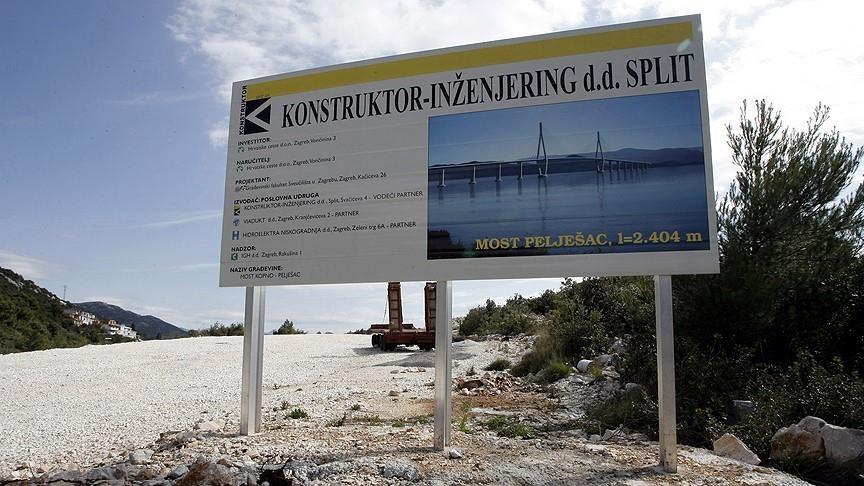ANALYSIS - “A Bridge Too Close?” The geopolitics of the Peljesac Bridge
As the EU funds its latest member state’s national interest, Bosnia’s access to the sea is being restricted
 FILE PHOTO
FILE PHOTO
The writer is an associate professor at the Faculty of Political Science at the University of Sarajevo
SARAJEVO
On 7 June 2017, the EU decided to allocate €357 million for the construction of a bridge that will link two parts of Croatian territory. The European Commission statement announcing the funding for the 2.4-km bridge was framed in EU-esque polite-sounding, tourism-friendly language.
The contract to build the bridge was awarded to China’s state-owned China Road and Bridge Corporation (CRBC) in January 2018, with a bidding price of US$340 million without VAT. According to Luka Ivan Jukic, the Peljesac Bridge is the first major EU-funded infrastructure project undertaken by the Chinese. The Chinese company outbid its competitors by committing to complete the project both quicker and cheaper. In April 2019, China’s Prime Minister Li Keqiang visited the construction site with Croatian premier Andrej Plenkovic. Initially scheduled to be completed this year, the project has been pushed back for a year. According to Plenkovic, the construction of the bridge is now scheduled to be completed in June 2022.
This, however, is not a bridge without controversy. Absent from the European Commission statement announcing the funding in 2017 was any mention of the fact that the bridge would block Bosnia and Herzegovina’s access to the open sea. In fact, the Peljesac Bridge seeks to bypass Bosnian territory and the coastal town of Neum. Croatia’s national interest in seeking a contiguous link between two sections of its territory comes at the expense of Bosnia’s access to the sea. Particularly contentious is the height of the bridge – 55 meters –, as it could potentially obstruct the entry of large ships into Bosnian territory.
The Neum corridor is a historical peculiarity. In 1699, the ownership of the small fishing village of Neum passed from the Dubrovnik Republic to the Ottomans. The logic of the Dubrovnik Republic was that this transfer of control would help insulate them from conquest by Venetians. In other words, by transferring control to the Ottomans, the Dubrovnik Republic was establishing an Ottoman-controlled buffer zone with the Venetians. As Dr. Andras Riedlmayer of Harvard University points out, during the Austro-Hungarian administration of Bosnia (1878-1918) and during the two Yugoslavias (1918-1992), the Neum border was an internal one.
Two recent historical events led to the current controversy and the dispute between Croatia and Bosnia. First, Yugoslavia’s dissolution in the early 1990s left Croatia with the longest coastline and Bosnia with just 12 miles between Croatian territory. It was in the aftermath of the Yugoslav dissolution that the Neum corridor became an international border.
When Croatia and Bosnia were part of Yugoslavia, the rationale for the bridge did not exist as it was all one country. Due to the breakup of Yugoslavia, traveling from the historical city of Dubrovnik to Split now entails passing through Bosnia and its border checkpoints. The Croatian-Bosnian borders on the Adriatic, according to Foreign Policy’s Michael Dobbs, is “the world’s most ridiculous border.” Then, in 2013, Croatia joined the EU and the imperative of beefing up the EU’s external borders took hold. Two factors combined to determine Croatia’s, and now the EU’s, drive to build the bridge. The Neum corridor, which divides Croatian territory, will be bypassed through the construction of the Peljesac Bridge.
The Peljesac Bridge has been in the works for a long time, and there has been much debate about its construction over the last fifteen years. The project had seemed to be shelved when the Great Recession struck, only to be resuscitated when the European Commission allocated most of the necessary funding in 2017.
In Bosnia, Bosnian Croat officials have toed Croatia’s line. It is Bosniak politicians who have spoken out – mostly in a haphazard fashion – against the construction of the bridge. Their objections to the Peljesac Bridge have taken the form of inconsequential open letters aimed far more at domestic political consumption than at altering Croatia’s determined course. Several high-level Bosniak officials are said to hold dual citizenship (Bosnian and Croatian) as well as real estate interests in Croatia, which may explain their convenient silence amid this controversy.
Given Bosnia’s coastline of only 12 miles, the construction of the Peljesac Bridge has geopolitical implications. Ken Jennings writes that Bosnia has the “second shortest coastline in the world” – after Monaco. For a country with a history of repeated neighborly attempts to carve it out, Bosnia’s continued access to the Adriatic Sea is vital.
In short, a Chinese state-owned company currently building a Croatian bridge with EU money for the purpose of bypassing Bosnian territory has raised concerns among Bosniaks, who are worried about the country’s future security.
As the EU funds its latest member state’s national interest, Bosnia’s access to the sea is being restricted. In the event of a potential conflict, access to the open sea is crucial for the country’s defense. What the Peljesac Bridge controversy shows is that membership in the EU can help a country pursue a national interest it would otherwise be unable to achieve. Dealt a bad hand, Bosnia can play it best by pursuing NATO membership for the purpose of safeguarding its internal peace and external borders.
*Opinions expressed in this article are the author’s own and do not necessarily reflect the editorial policy of Anadolu Agency.
Anadolu Agency website contains only a portion of the news stories offered to subscribers in the AA News Broadcasting System (HAS), and in summarized form. Please contact us for subscription options.

